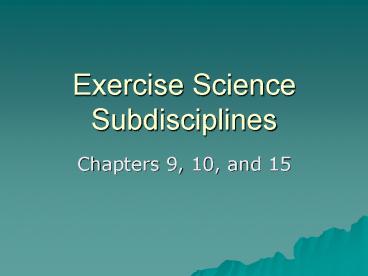Exercise Science Subdisciplines - PowerPoint PPT Presentation
1 / 15
Title:
Exercise Science Subdisciplines
Description:
How nutrition affects exercise performance at all levels ... The higher the intensity of exercise, the more important glycogen is as a fuel ... – PowerPoint PPT presentation
Number of Views:110
Avg rating:3.0/5.0
Title: Exercise Science Subdisciplines
1
Exercise Science Subdisciplines
- Chapters 9, 10, and 15
2
Sports Nutrition
- Concerned with applying nutritional principles to
sports - Deals mainly with
- How nutrition affects exercise performance at all
levels - How nutrition affects physical performance
- The effects of ergogenic aids on nutrition and
physical performance
3
Metabolic aspects of exercise
Nutrition for the athlete
Weight issues
Special needs of athletes
4
Proper nutrition and exercise
- It is the responsibility of all fitness
professionals to understand what constitutes
optimal nutrition for fitness and athletics - Daily nutritional practices are the more critical
factor - No amount of dietary manipulation the day of
and/or the day before competition can make up for
otherwise poor nutritional habits
5
Carbohydrates Fuel for the body
- Several important facts about CHO as a fuel for
exercise - Preferred fuel source by the body
- The higher the intensity of exercise, the more
important glycogen is as a fuel - The body can only store limited amounts of CHO
training increases ability to store/spare - Fat metabolism is linked to CHO metabolism
6
Fats You do need them
- Between 20 and 30 of your total calories should
be from fat - 2000 kcal/day diet ? 400-600 kcal of this as fat
45-67 g/fat/day - Saturated, monounsaturated, and polyunsaturated
7
Protein More than just muscle
- The RDA of protein for US adults is
- 0.8 g per kg for average male and female
- 1.0-1.4 g/kg/day for endurance team sport
athletes - 1.4-1.7 g/kg/day for strength athletes
- Beneficial in which the primary goal is a large
increase in muscle mass - Additional protein may be beneficial to ensure
repair of any damaged muscle fiber - Minimal evidence that a.a. supplementation in
excess will enhance muscle hypertrophy or
strength attainment - Increased protein might benefit ultra-endurance
training and recovery from exercise
8
Vitamins Minerals The micronutrients
- Do not provide energy, but are involved in
energy-producing reactions. - Major minerals (calcium, chlorine, magnesium,
phosphorus, potassium, sodium, and sulfur)
fluid ingestion during exercise - Five trace minerals (zinc, chromium, copper,
selenium, and iron) - Consumption of real foods is the best way to
obtain (most absorptive) - There is no evidence that vitamin and mineral
supplementation improves exercise or athletic
performance, speeds up recovery, decreases
injuries
9
Additional information
- Hydration Drink before you are thirsty
- Hypohydrated
- Water intoxication/hyponatremia
- Weight loss and Athletic performance
- Ergogenic Aids
- Creatine
- Caffeine
- BCAAs
10
Physical Activity Epidemiology
- Involves the specific investigation of the
relationship between PA and exercise and various
diseases and conditions in a population. - Newest subdiscipline has earned national
recognition - PIa is a major risk factor for a number of
chronic diseases
11
How is Epidemiology Used?
- Fourfold fashion
- 1. establish cause (i.e. environment
- or genetics)
- 2. trace the history of a disease
- 3. describe the health status of a population
to determine the total burden of disease - 4. evaluate the success or failure of an
intervention
12
Advances in PA Epidemiology
- PA and Health A Report of the Surgeon General
(1996) - The prevalence of sedentary behavior in the US
- ACSM/CDC Position Stands
13
How much PA is enough?
- Needs to be clarified and specified in order to
prescribe appropriate amount for physical health
benefits - Need to identify variations in dose-response
relationships between different populations
14
Exercise and Sport Psychology
- Study of human behavior, both in individual and
group contexts, in exercise- and sport-related
environments. - 2 primary concerns
- How do exercise and sport affect ones
psychological makeup? - How can the principles of psychology be used to
improve exercise and sport performance?
15
Exercise and Sport Psychology
- Activities
- Teaching
- Research
- Consulting
- Areas of Study
- Exercise and mood state
- Exercise Adherence
- Personality and sport performance






























